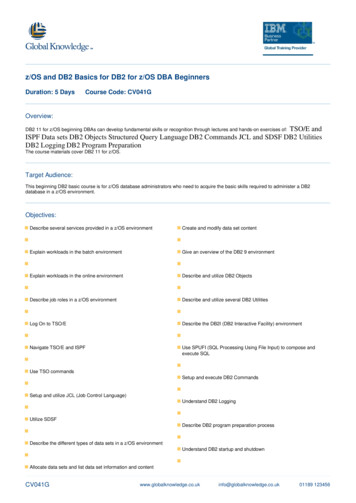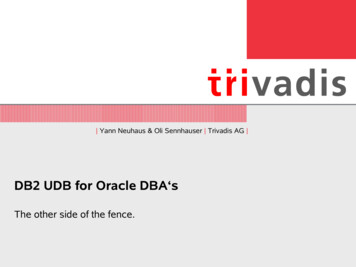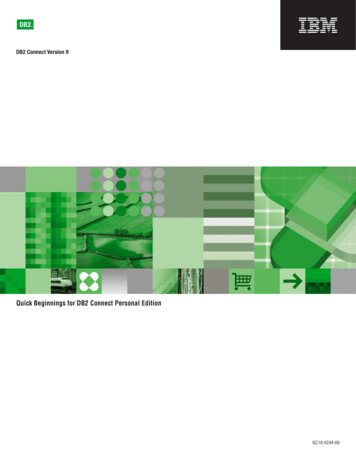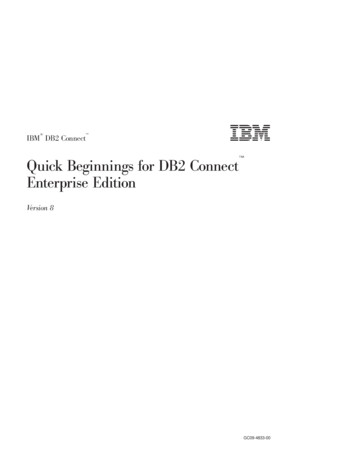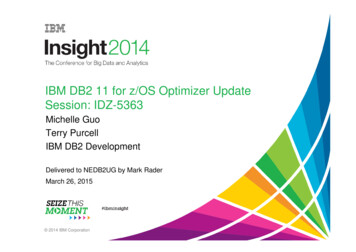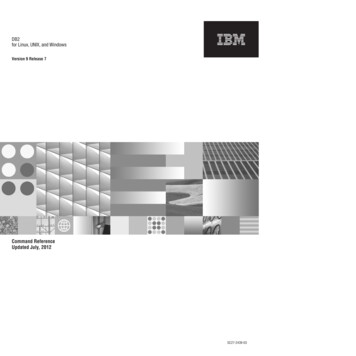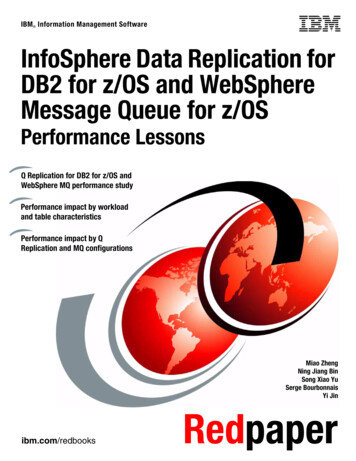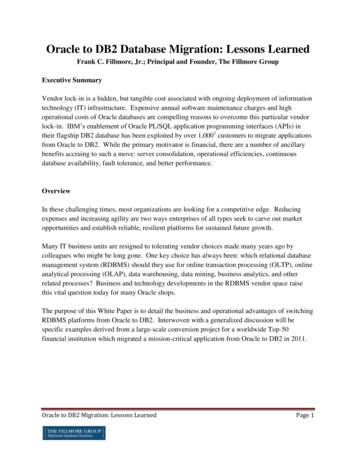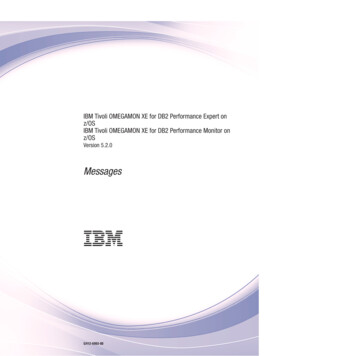
Transcription
IBM Tivoli OMEGAMON XE for DB2 Performance Expert onz/OSIBM Tivoli OMEGAMON XE for DB2 Performance Monitor onz/OSVersion 5.2.0Messages GH12-6993-00
IBM Tivoli OMEGAMON XE for DB2 Performance Expert onz/OSIBM Tivoli OMEGAMON XE for DB2 Performance Monitor onz/OSVersion 5.2.0Messages GH12-6993-00
NoteBefore using this information and the product it supports, read the information in “Notices” on page 365.First edition, October 2013This edition applies to the following releases and to all subsequent releases and modifications until otherwiseindicated in new editions:v IBM Tivoli OMEGAMON XE for DB2 Performance Expert on z/OS, version 5, release 2, modification 0(5655-W37)v IBM Tivoli OMEGAMON XE for DB2 Performance Monitor on z/OS, version 5, release 2, modification 0(5655-W38)This edition replaces GH12-6965-00. Copyright IBM Corporation 1985, 2013.US Government Users Restricted Rights – Use, duplication or disclosure restricted by GSA ADP Schedule Contractwith IBM Corp.
ContentsAbout this publication. . . . . . . . . . . . . . . . . . . . . . . . . . . . . vConventions used in the OMEGAMON documentation .Terminology used . . . . . . . . . . . .How to read syntax diagrams . . . . . . . .Where to find information . . . . . . . . .Service updates and support information . . . . .Accessibility features . . . . . . . . . . .How to send your comments . . . . . . . . v. vii. vii. ix. x. x. xiWhat's new . . . . . . . . . . . . . . . . . . . . . . . . . . . . . . . . . xiiiChapter 1. Introduction to OMEGAMON XE for DB2 PE messages. . . . . . . . . . . 1The layout of message descriptions .The structure of message numbers . 1. 1Chapter 2. When you contact IBM support . . . . . . . . . . . . . . . . . . . . . 5Chapter 3. Buffer Pool Analyzer messages (BPOK) . . . . . . . . . . . . . . . . . 7Chapter 4. Workstation client messages (DGOK) . . . . . . . . . . . . . . . . . . 11**** MISSING FILE ****. 24Chapter 5. Performance Warehouse messages (DGOP) . . . . . . . . . . . . . . . 25Chapter 6. Accounting report set messages (FPEA) . . . . . . . . . . . . . . . . 35Chapter 7. User-Tailored Reporting messages (FPEB) . . . . . . . . . . . . . . . 39Chapter 8. Background Control messages (FPEC) . . . . . . . . . . . . . . . . . 43Chapter 9. Exception Processing messages (FPEE) . . . . . . . . . . . . . . . . 71Chapter 10. Interactive Report Facility messages (FPEF) . . . . . . . . . . . . . . 75**** MISSING FILE ****. 88Chapter 11. I/O Activity report set messages (FPEI) . . . . . . . . . . . . . . . . 89Chapter 12. Installation and Configuration messages (FPEJ) . . . . . . . . . . . . 91Chapter 13. Locking report set messages (FPEL) . . . . . . . . . . . . . . . . . 95Chapter 14. Online Monitor messages (FPEM) . . . . . . . . . . . . . . . . . . . 97Chapter 15. Record Trace messages (FPEN) . . . . . . . . . . . . . . . . . . . 141Chapter 16. Spreadsheet Input Data Generator (FPEP). . . . . . . . . . . . . . . 143Chapter 17. Buffer Pool Analyzer messages (FPEQ) . . . . . . . . . . . . . . . . 147Chapter 18. SQL Activity report set messages (FPER) . . . . . . . . . . . . . . . 149 Copyright IBM Corp. 1985, 2013iii
Chapter 19. Statistics report set messages (FPES) . . . . . . . . . . . . . . . . 151Chapter 20. Utility Activity report set messages (FPET) . . . . . . . . . . . . . . 153Chapter 21. Utility Services messages (FPEU) . . . . . . . . . . . . . . . . . . 155Chapter 22. Data Server messages (FPEV) . . . . . . . . . . . . . . . . . . . . 159Chapter 23. System Parameters report set messages (FPEW). . . . . . . . . . . . 211Chapter 24. Audit report set messages (FPEX) . . . . . . . . . . . . . . . . . . 213Chapter 25. Explain report set messages (FPEY) . . . . . . . . . . . . . . . . . 215Chapter 26. Migrate/Convert function messages (FPEZ) . . . . . . . . . . . . . . 225Chapter 27. Tivoli Enterprise Monitoring Agent (TEMA) for DB2 messages (KDP) . . . 227Chapter 28. D5API Collection for TEP and E3270ui (KO2D) . . . . . . . . . . . . . 237Chapter 29. Object Analysis messages (KO2E) . . . . . . . . . . . . . . . . . . 239**** MISSING FILE **** . 243Chapter 30. Near-Term History Data Collector messages (KO2H) . . . . . . . . . . 245Chapter 31. D5API Framework messages (KO2I) . . . . . . . . . . . . . . . . . 253Chapter 32. ISPF messages (KO2M). . . . . . . . . . . . . . . . . . . . . . . 267Chapter 33. VTAM Display Logic messages (KO2O) . . . . . . . . . . . . . . . . 269Chapter 34. Capture Server messages (KO2R) . . . . . . . . . . . . . . . . . . 313Chapter 35. Storage Manager messages (KO2S) . . . . . . . . . . . . . . . . . 323Chapter 36. Cross-Memory Module messages (KO2X) . . . . . . . . . . . . . . . 327Chapter 37. OMEGAMON PE Subsystem messages (KO2Z). . . . . . . . . . . . 329Notices . . . . . . . . . . . . . . . . . . . . . . . . . . . . . . . . . . . 365Trademarks . 367Bibliography . . . . . . . . . . . . . . . . . . . . . . . . . . . . . . . . . 369Index . . . . . . . . . . . . . . . . . . . . . . . . . . . . . . . . . . . . 371ivOMEGAMON XE for DB2 PE & PM: Messages
About this publicationThis information shows and describes the messages that are produced by thefollowing products:v IBM Tivoli OMEGAMON XE for DB2 Performance Expert on z/OS v IBM Tivoli OMEGAMON XE for DB2 Performance Monitor on z/OSFor the most current version of this publication, always check the followingwebsites:v DB2 Tools Product Pagev Tivoli Documentation CentralWho should read this publicationThis publication is intended for IBM data server professionals who use reports andtraces to monitor DB2 database activity for:vvvvvDetermining system performance and efficiencyTuningIdentifying bottlenecksMeasuring an application's performance and resource costEvaluating the effects of applications on other applications and the systemConventions used in the OMEGAMON documentationThis information uses several conventions for special terms and actions, andoperating system-dependent commands and paths.Panels and figuresThe panels and figures in this document are representations. Actual product panelsmight differ.SymbolsThe following symbols might appear in command syntax:SymbolUsage The or symbol is used to denote a choice. You can use theargument on the left or the argument on the right. For example:YES NOIn this example, you can specify YES or NO.()Denotes optional arguments. Arguments that are not enclosed insquare brackets are required. For example:APPLDEST DEST (ALTDEST)In this example, DEST is a required argument and ALTDEST isoptional. Copyright IBM Corp. 1985, 2013v
SymbolUsage{}Some documents use braces to denote mandatory arguments, or togroup arguments for clarity. For example:COMPARE {workload} - REPORT {SUMMARY HISTOGRAM}In this example, the workload variable is mandatory. The REPORTkeyword must be specified with a value of SUMMARY orHISTOGRAM.Default values are underscored. For example:COPY infile outfile - [COMPRESS {YES NO}]In this example, the COMPRESS keyword is optional. If specified,the only valid values are YES or NO. If omitted, the default isYES.Notation conventionsThe following conventions are used when referring to high-level qualifiers:hilevA high-level qualifier. The high-level qualifier is the first prefix or set ofprefixes in the data set name. Site-specific high-level qualifiers are shownin italics.For example:v thilev refers to the high-level qualifier for your target data set.v rhilev refers to the high-level qualifier for your runtime data set.For members in target libraries, the high-level qualifier is thilev ratherthan rhilev.v shilev refers to the SMP/E library high-level qualifier.Typeface conventionsThis information uses the following typeface conventions:Boldv Interface controls (check boxes, push buttons, radio buttons, spinbuttons, fields, folders, icons, list boxes, items inside list boxes,multicolumn lists, containers, menu choices, menu names, tabs, propertysheets), labels (such as Note:)v Keywords and parameters in textItalicv Words defined in textv Emphasis of words (for example: Use the word that to introduce arestrictive clause.)v New terms in text (except in a definition list)Monospacedv Examples and code examplesv File names, programming keywords, and other elements that are difficultto distinguish from surrounding textv Message text and prompts addressed to the userv Text that the user must typeviOMEGAMON XE for DB2 PE & PM: Messages
v Values for arguments or command optionsSignificant elementsRecommendationProvides guidance when more than one option is available.Related readingRefers you to other publications that contain relevant information.RequirementIdentifies a condition that must be met to ensure that the productis functional.RestrictionIdentifies a restriction or limitation with this product or anassociated procedure.Terminology usedIBM Tivoli OMEGAMON XE for DB2 Performance Monitor on z/OS can beconsidered as a functional subset of IBM Tivoli OMEGAMON XE for DB2Performance Expert on z/OS. Therefore the abbreviation OMEGAMON XE for DB2PE or DB2 PE is used for both products. If a distinction is required, OMEGAMONXE for DB2 PM or DB2 PM is used explicitly.The following table shows the products that are described in this publication andthe short names with which they are referred to throughout this publication:Table 1. Product names and their short namesProduct nameShort nameIBM Tivoli OMEGAMON XE for DB2Performance Expert on z/OSOMEGAMON XE for DB2 PE or DB2 PEIBM Tivoli OMEGAMON XE for DB2Performance Monitor on z/OSOMEGAMON XE for DB2 PM or DB2 PMIBM DB2 Buffer Pool Analyzer for z/OS or a Buffer Pool Analyzerparticular subsystemIBM DB2 database for z/OSDB2v Performance Expert Client and Workstation Online Monitor designate the clientcomponent of DB2 PE.The client component of DB2 PE also designates the end user interface ofPerformance Expert for Multiplatforms, Performance Expert for Workgroups,and DB2 PE.v OMEGAMON Collector designates the server component of DB2 PE.How to read syntax diagramsThe rules in this section apply to the syntax diagrams that are used in thispublication.Arrow symbolsRead the syntax diagrams from left to right, from top to bottom, followingthe path of the line. Two right arrows followed by a line indicate the beginning of astatement.About this publicationvii
One right arrow at the end of a line indicates that the statementsyntax is continued on the next line. One right arrow followed by a line indicates that a statement iscontinued from the previous line. A line followed by a right arrow and a left error indicates the endof a statement.Conventionsv SQL commands appear in uppercase.v Variables appear in italics (for example, column-name). They representuser-defined parameters or suboptions.v When entering commands, separate parameters and keywords by atleast one blank if there is no intervening punctuation.v Enter punctuation marks (slashes, commas, periods, parentheses,quotation marks, equal signs) and numbers exactly as given.v Footnotes are shown by a number in parentheses, for example, (1).Required itemsRequired items appear on the horizontal line (the main path). REQUIRED-ITEM Optional itemsOptional items appear below the main path. REQUIRED-ITEM optional-itemIf an optional item appears above the main path, that item has no effect onthe execution of the statement and is used only for readability.optional-item REQUIRED-ITEM Multiple required or optional itemsIf you can choose from two or more items, they appear vertically in astack. If you must choose one of the items, one item of the stack appears onthe stack main path. REQUIRED-ITEMrequired-choice1required-choice2 If choosing one of the items is optional, the entire stack appears below themain path. required-choice1required-choice2viiiOMEGAMON XE for DB2 PE & PM: Messages
Repeatable itemsAn arrow returning to the left above the main line indicates that an itemcan be repeated. REQUIRED-ITEM repeatable-item If the repeat arrow contains a comma, you must separate repeated itemswith a comma., REQUIRED-ITEM repeatable-item If the repeat arrow contains a number in parenthesis, the numberrepresents the maximum number of times that the item can be repeated.(5) REQUIRED-ITEM repeatable-item A repeat arrow above a stack indicates that you can specify more than oneof the choices in the stack.Default keywordsIBM-supplied default keywords appear above the main path, and theremaining choices are shown below the main path. In the parameter listfollowing the syntax diagram, the default choices are underlined.default-choice required-choice1required-choice2Where to find informationYou can access the documentation in several ways.The documentation for this product is provided in PDF and in HTML format at thefollowing websites:v Tivoli OMEGAMON XE for DB2 Performance Expert on z/OSv Tivoli OMEGAMON XE for DB2 Performance Monitor on z/OSAccessing publications onlineIBM posts publications for this and all other Tivoli products, as they becomeavailable and whenever they are updated, to the Tivoli software Knowledge Centerwebsite. You can access the Tivoli software Knowledge Center by going to theTivoli Documentation Central website and clicking O under Tivoli DocumentationA-Z to access all of the IBM Tivoli OMEGAMON product manuals.About this publicationix
Note: If you print PDF documents on other than letter-sized paper, set the optionin the File Print window that allows Adobe Reader to print letter-sized pages onyour local paper.The IBM Software Support website provides the latest information about knownproduct limitations and workarounds in the form of technotes for your product.You can view this information at the Support home website.Ordering publicationsYou can order many IBM publications such as product manuals or IBM Redbooks online at the IBM Publications Center website.You can also order by telephone by calling one of the following numbers:v In the United States: 800-879-2755v In Canada: 800-426-4968In other countries, contact your software account representative to order Tivolipublications.Accessing terminology onlineThe IBM Terminology website consolidates the terminology from IBM productlibraries in one convenient location.Service updates and support informationYou can access support information for IBM Tivoli OMEGAMON XE for DB2Performance Expert on z/OS and IBM Tivoli OMEGAMON XE for DB2Performance Monitor on z/OS on the Support home website, or you can use theIBM Support Assistant.Support homeOn the Support home website, you can find service updates and supportinformation including software fix packs, PTFs, Frequently Asked Questions(FAQs), technical notes, troubleshooting information, and downloads.Accessibility featuresAccessibility features help people with a physical disability, such as restrictedmobility or limited vision, or with other special needs, to use software productssuccessfully. This Knowledge Center is developed to comply with the accessibilityrequirements of software products according to Section 508 of the RehabilitationAct of the United States.The accessibility features in this Knowledge Center enable users to do thefollowing tasks:v Use assistive technologies, such as screen-reader software and digital speechsynthesizer, to hear what is displayed on the screen. In this Knowledge Center,all information is provided in HTML format. Consult the product documentationof the assistive technology for details on using assistive technologies withHTML-based information.v Operate specific or equivalent features using only the keyboard.v Magnify what is displayed on the screen.xOMEGAMON XE for DB2 PE & PM: Messages
In addition, all images are provided with alternative text so that users with visionimpairments can understand the contents of the images.Navigating the interface by using the keyboardStandard shortcut and accelerator keys are used by the product and aredocumented by the operating system. Refer to the documentation provided byyour operating system for more information.Magnifying what is displayed on the screenYou can enlarge information in the product windows using facilities provided bythe operating systems on which the product is run. For example, in a MicrosoftWindows environment, you can lower the resolution of the screen to enlarge thefont sizes of the text on the screen. Refer to the documentation provided by youroperating system for more information.How to send your commentsYour feedback is important in helping to provide the most accurate andhigh-quality information.If you have any comments about this information or any other documentation, youcan do one of the following actions:v Complete and submit the Reader Comment Form .v Send your comments by e-mail to swsdid@de.ibm.com.Include the documentation name, the part number, the version number, and, ifapplicable, the specific location of the text you are commenting on (for example,a page number or table number).About this publicationxi
xiiOMEGAMON XE for DB2 PE & PM: Messages
What's newThis topic summarizes the significant improvements or enhancements for thisproduct and refers you to the relevant topics for more information.GH12-6993-00 - October 2013This edition replaces IBM Tivoli OMEGAMON XE for DB2 PerformanceExpert on z/OS; IBM Tivoli OMEGAMON XE for DB2 Performance Monitor onz/OS: Messages, GH12-6965-00.In OMEGAMON XE for DB2 PE, DB2 version 8 is no longer supported.In this edition, messages are updated or new messages are added in thefollowing messages components for the following functions:Background control messages (FPEC)The following items are no longer supported:v DISTRIBUTE command keywordv DISTDD optionv For the Statistics report set, the SPREADSHEETDD FILEsubcommand option keywordNew messages that are related to long names with variable lengthare added.Accounting report set messages (FPEA)Autonomous Procedure DataOnline Monitor messages (FPEM)A particular version of a subsystem might not be supported for thecurrent version of OMEGAMON XE for DB2 PE.Data Server messages (FPEV)Stored Procedures monitoringDISTRIBUTE messages (FPED)DISTRIBUTE messages are no longer required.D5API Collection for TEP and E3270ui (KO2D)New messages are added for TEP and E3270ui.VTAM Display Logic messages (KO2O)ATF data is from an unsupported DB2 version.OMEGAMON PE Subsystem messages (KO2Z)Initialization of DB2 routing table. Copyright IBM Corp. 1985, 2013xiii
xivOMEGAMON XE for DB2 PE & PM: Messages
Chapter 1. Introduction to OMEGAMON XE for DB2 PEmessagesThis information lists all messages and provides additional explanations andpossible user actions for each message. The messages are listed in alphanumericsequence. This section introduces the message layout and describes the structure ofmessage numbers.The layout of message descriptionsMessages are described according to the following layout:Message number and message text, as provided by the systemThe message number is described in “The structure of message numbers.”The message text provides a short description of the event or problem.Many actual messages contain one or more variable text parts. These partsare shown as numbered message variables in message texts (for example, V1 ). The texts for the variables are given in the explanation of themessages. Variable text for workstation client messages is shown asnumbered message variables within curly braces, for example {1}.ExplanationA more detailed explanation of the message, or additional informationabout the message.System ActionA description of how the system responds to the event that caused thismessage. This part might be intentionally missing, if obvious.User ResponseA description of possible user actions to solve the problem. This part mightbe intentionally missing, if obvious.The structure of message numbersMessage numbers have fourfold structure that consists of prefix, subcomponentidentifier, number, and severity code.Prefix A three-character prefix that identifies the product or major componentthat issues a message.BPO The Buffer Pool Analyzer program prefix.DGO Prefix that identifies workstation client messages.FPEThe OMEGAMON XE for DB2 PE program prefix (componentsfrom former IBM DB2 Performance Expert product).KDP The Tivoli Enterprise Monitoring Agent (TEMA) for DB2 programprefixKO2 The OMEGAMON XE for DB2 PE program prefix (componentsfrom the former OMEGAMON II product).Subcomponent identifierA one-character subcomponent identifier that identifies the subcomponentwithin a product or major component. For example, in messageFPEA1242I, the A identifies the Accounting subcomponent inOMEGAMON XE for DB2 PE. Copyright IBM Corp. 1985, 20131
BPO messages use a single subcomponent identifier K, which means thatall Buffer Pool Analyzer messages start with BPOK.DGO messages use a single subcomponent identifier K, which means thatall workstation client messages start with DGOK.FPE messages use the following subcomponent identifiers:AAccountingBUser-Tailored Reporting (part of Batch feature)CBackground controlEException processingFInteractive Report Facility (part of Batch feature)II/O activityJInstallation and customizationLLockingMOnline MonitorRSQL activitySStatisticsTUtility activityUUtility servicesVData ServerWSystem Parameters report setXAuditYExplainZMigrate/Convert functionKDP messages do not have explicit subcomponent identifiers.KO2 messages use the following subcomponent identifiers:AReserved for Application Trace Facility (ATF)CReserved for Interface, Cross-Memory, Display ModuleDReserved for Data Analysis ModuleEObject AnalysisHNear-Term History Data CollectorIReserved for D5API FrameworkMISPFOVTAM Display LogicPReserved for D5API CollectorsRCapture ServerSStorage ManagerTReservedUReserved for Utility I/O and Data Conversion RoutinesXCross-Memory ModuleZOMPE SubsystemMessage numberA unique number within the range of messages from a subcomponent.SeverityAn appending single-letter code that indicates the severity of the message.2IInformational message that does not require any user action.WWarning message that should be analyzed to determine whetherthe condition can effect the results. Usually, a warning messagedoes not prevent the system from execution.EError message that can be corrected by an appropriate user action(for example, by correcting a command syntax error).SSevere error message that results from an abnormal condition andOMEGAMON XE for DB2 PE & PM: Messages
in the abandonment of processing for a command. Othercommands in a job stream may still be executed.UUnrecoverable error message that results from an abnormalcondition and in the abandonment of processing for the entire job.Most internal errors fall into this category.Chapter 1. Introduction to OMEGAMON XE for DB2 PE messages3
4OMEGAMON XE for DB2 PE & PM: Messages
Chapter 2. When you contact IBM supportIf you discover an error or receive a message where the user response is “ContactIBM support”, collect the following data before contacting IBM support to assist indetermining the cause of the errors:v The complete list of PTFs and maintenance PUT tapes installed, for DB2 andOMEGAMON XE for DB2 PE.v The complete dump listing from SYSABEND or SYSUDUMP.v All error messages, some of which might contain DB2 return codes and reasoncodes. To interpret the DB2 codes, read DB2 Messages and Codes.v The listing of the SYSLOG data set for the period of time spanning the failure.If the problem originated in the background (Batch) execution of a report, alsocollect:v The complete run listing (including all steps), JCL command stream, SYSPRINTlog, job summary log, trace record distribution report, and system parametersreport, if available.v The complete report or trace listing in question.If the problem originated in the Host Online Monitor, the IRF, or the foregroundexecution of a report, also collect the following data:v The complete list of PTFs and maintenance PUT tapes installed for ISPF, inaddition to OMEGAMON XE for DB2 PE and DB2.v The listing of the ISPF log for the session involved in the problem.v The panel ID, the message number and text of any error messages, and adescription of the sequence of events immediately preceding the error.If the problem originated in OMEGAMON Collector, also collect the followingdata:v The SYSPRINT logv The History data setv The Exception Events data setv An SVCDUMP of both the OMEGAMON Collector and the user experiencingthe problem when the problem occurred, or as soon after as possible.With any reported problem, the input data might be needed to perform furtherproblem determination. Save the following data sets:v The files that were input to the foreground or background execution ofOMEGAMON XE for DB2 PE reporting. Save the SMF, GTF, DPMOUT, or HostOnline Monitor data sets that were used as input to the report.Note: If a report problem was experienced when executing in foreground, itmight be easier to document the problem by executing the same report with thesame input data in background to gather the necessary information.v The Exception Threshold data set. If the problem involves exception processing,save the contents of this data set from the time of the problem onwards. Copyright IBM Corp. 1985, 20135
6OMEGAMON XE for DB2 PE & PM: Messages
Chapter 3. Buffer Pool Analyzer messages (BPOK)BPOK5000The bpd file does not contain allrequired information.Explanation: The bpd file was generated with anearlier version of Buffer Pool Analyzer.User response: Update your host version of BufferPool Analyzer and generate new bpd files.BPOK5001The size for one or more objects isunknown.Explanation: These objects are treated as if they hadsize zero.User response: Use the RUNSTATS tools on a regularbasis to initialize object sizes.User response: If the problem persists, contact IBMsupport.BPOK5007Explanation: The directory was not created or wasdeleted.BPOK5008One or more objects are not placedcorrectly.Explanation: {0}User response: Edit column 'User-defined' to map therespective objects to valid buffer pools.BPOK5003The value supplied for {0} is not a validdecimal number.Explanation: A valid decimal number consists ofdigits and optionally a dot.User response: Type a valid decimal number in thecorresponding field.BPOK5004Negative numbers are not allowed fortotal sizes. This applies to buffer poolsand hiperpools.No data view selected.Explanation: There is no data view that has the focus.User response: Select a data view or generate one bydouble-clicking on a suitable leaf in the tree. Then tryagain the operation.BPOK5009BPOK5002The directory {0} does not exist.The file that you opened is corrupted.Explanation: Record type is not valid: {0}. Possiblevalues are: 'D', 'B', 'O', 'S'. Processing stopped.User response: The file was generated in a wrongway, was corrupted during transfer, or was transferredby FTP in a mode other than binary mode.BPOK5010The file that you opened is corrupted.Explanation: The record type is not registered: {0}.Record types are registered by a previous create/loadstatement pair. Processing stopped.User response: The file was probably generated in awrong way.BPOK5011The value supplied for {0} is not a validinteger.Explanation: Integers consist of digits only.Explanation: Negative numbers for storage amountsare not allowed.User response: Enter a valid integer and try again.User response: Specify storage amounts by usingpositive numbers.BPOK5012The value supplied for {0} is out ofrange.Explanation: The range is from {1} to {2}.BPOK5005The sum of virtual and hiperpool sizescannot be zero.Explanation: A system without storage does not workcorrectly.User response: Specify a virtual pool size and,optionally, a hiperpool size.BPOK5006The program cannot process the data.User response: Enter a number within the range andtry again.BPOK5013The relation between the minimum andthe maximum value is incorrect.Explanation: The maximum value must be greaterthan the minimum value.User response: Correct the numbers accordingly.Explanation: Contents of column {0} for chart {1}cannot be loaded. Copyright IBM Corp. 1985, 20137
BPOK5014 BPOK5102BPOK5014Do you want to save your changedpattern file?BPOK5015One or more values of the characteristicsdata are not valid.Explanation: {0}User response: Correct the values accordingly.BPOK5017All data values in the requested dataview are zero.Explanation: Empty data views are not created.BPOK5018Do you want to permanently delete thereport?BPOK5023The system is out of memory.Explanation: The size of the available memory issmaller than the size of the memory required to openthe selected input file.User response: Close all applications that are currentlynot needed. Then try again the operation.BPOK5024Sorting by table headers will bedisabled. A very large number ofobjects are displayed and sorting wouldbe slow.Explanation: The amount of data to sort is so greatthat the sort would take too long.User response: Select an entry from the list ofrecommended patterns.BPOK5036Explanation: A pattern file is required to map objectsto buffer pools.User response: Select an entry from the list ofuser-defined patterns.BPOK5037The buffer pool data file is notcompatible.Explanation: The selected buffer pool data file cannotbe used for Object Placement because it was generatedwith a version of Performance Expert or Buffer PoolAnalyzer before PTF E.User response: Use bpd files that were created on ahost with Performance Expert or Buffer Pool Analyzerhaving at least PTF E installed.BPOK5034Parsing of buffer pool data file failed.Explanation: The selected file is not a va
stack. If you must choose one of the items, one item of the stack appears on the stack main path. REQUIRED-ITEM required-choice1 required-choice2 If choosing one of the items is optional, the entire stack appears below the main path. required-choice1 required-choice2 viii OMEGAMON XE for DB2 PE & PM: Messages
